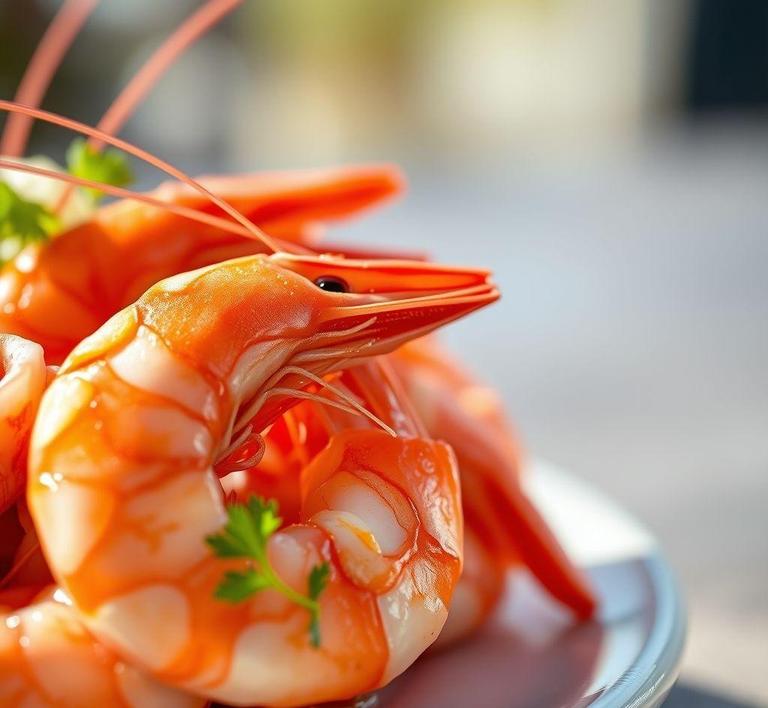Refreezing boiled shrimp might seem tricky, but with the right steps, you can maintain their texture and flavor. Whether you’ve cooked up a big batch and have leftovers or bought too much for a single meal, knowing how to properly store and refreeze boiled shrimp can save you from wasting perfectly good seafood. The key is to handle them carefully to prevent freezer burn and preserve their quality, so your shrimp stay juicy and tender when you’re ready to enjoy them again. In this guide, we’ll walk you through the best methods to refreeze boiled shrimp, ensuring they stay just as delicious the second time around!
Can You Refreeze Boiled Shrimp?

When it comes to refreezing boiled shrimp, the answer is a bit more nuanced than a simple "yes" or "no." Technically speaking, yes, you can refreeze boiled shrimp. However, whether you should is where things get tricky. Refreezing shrimp that has already been boiled introduces several factors that can impact both the texture and the safety of the shrimp.
Shrimp, like other seafood, is highly perishable. The freezing process slows down the growth of bacteria, but it doesn’t necessarily kill them. When shrimp is thawed and then refrozen, there’s a potential for bacteria to multiply, especially if the shrimp has been left at room temperature for too long during the thawing process. For this reason, it’s important to follow proper food safety practices, especially with seafood, which is known for being more prone to bacterial contamination.
Another factor to consider is the effect of freezing on the texture of the shrimp. Boiling shrimp initially changes its cellular structure, and refreezing can exacerbate the damage. Ice crystals form within the shrimp, causing cell walls to break down. When refrozen, the shrimp’s delicate texture becomes more susceptible to becoming mushy or rubbery after reheating. So while refreezing boiled shrimp is possible, it may result in a less-than-ideal eating experience.
How To Refreeze Boiled Shrimp?
If you decide to go ahead with refreezing your boiled shrimp, it’s essential to take proper precautions to ensure the shrimp remains as safe and delicious as possible. Here’s a step-by-step guide on how to refreeze boiled shrimp properly:
1. Cool It Down Quickly
First, after boiling your shrimp, it’s crucial to cool them down as quickly as possible before freezing. This prevents bacteria from growing. You can do this by placing the shrimp in a shallow pan or bowl and putting it in an ice bath, or by running them under cold water. The faster you get the shrimp to a low temperature, the better.
2. Pat Dry
Once the shrimp has cooled down, use paper towels to gently pat them dry. Removing excess moisture is important because any water left on the shrimp can form ice crystals in the freezer, further damaging the shrimp’s texture.
3. Portion The Shrimp
If you’re only planning on using a portion of the shrimp later, it’s a good idea to divide it into meal-sized portions. This will make it easier to thaw only the amount you need and prevent repeated thawing and refreezing.
4. Wrap And Seal Properly
Place the shrimp into an airtight freezer bag or container. If you use a bag, make sure to squeeze out as much air as possible to prevent freezer burn. If you’re using a container, ensure the shrimp are tightly packed to minimize air exposure. If you want to go the extra mile, consider vacuum sealing the shrimp. This method removes all air, helping preserve the shrimp’s quality even longer.
5. Label And Freeze
Before placing the shrimp in the freezer, label the bag or container with the date it was boiled and frozen. This helps you keep track of how long it’s been in the freezer. For best results, it’s ideal to consume the shrimp within one to two months.
Quality Impact
The quality of boiled shrimp is directly affected by how it’s handled during freezing and thawing. Although refreezing doesn’t pose a major health risk if done properly, it will likely affect the shrimp’s texture, flavor, and overall quality. Let’s break down the main impacts:
Texture
Shrimp has a delicate, tender texture when freshly cooked. When refrozen, the water content inside the shrimp forms ice crystals, which can damage the cell structure. This results in shrimp that may become mushy or rubbery once thawed. The longer the shrimp is stored in the freezer, the more pronounced the texture degradation will be. Therefore, it’s best to consume refrozen shrimp within a month or two to minimize the loss of quality.
Flavor
Freezing shrimp, especially after boiling, can cause a slight loss in flavor. The cold temperatures can dull the natural sweetness and briny undertones of the shrimp. Additionally, if shrimp is not stored properly in an airtight container, it can absorb other freezer odors, which could further compromise its taste. The risk of flavor loss increases the longer the shrimp is stored, so quick consumption is advised.
Freezer Burn
One of the most significant risks to the quality of frozen shrimp is freezer burn. This occurs when the shrimp is exposed to air in the freezer, causing dehydration and oxidation. Freezer-burned shrimp will have an unappealing appearance, and their taste will be off-putting as well. Wrapping shrimp tightly and ensuring minimal air exposure are the best ways to prevent freezer burn.
While you can refreeze boiled shrimp, it’s generally not recommended unless necessary. The process of thawing and refreezing will impact the shrimp’s texture, flavor, and overall quality. If you decide to refreeze your shrimp, following proper food safety practices-like cooling it quickly, sealing it tightly, and labeling it with the date-is essential for minimizing quality loss. While refrozen shrimp can still be safe to eat if handled properly, the eating experience may be less than ideal due to the textural changes. To maintain the best quality, it’s always a good idea to consume shrimp sooner rather than later, and if possible, avoid refreezing to preserve the fresh taste and delicate texture of boiled shrimp.
Is It Safe To Refreeze Boiled Shrimp?
Refreezing boiled shrimp is a topic that raises questions for many home cooks and seafood lovers. The safety of refreezing shrimp, or any seafood for that matter, hinges largely on the handling and storage processes involved in its preparation, freezing, and thawing. In theory, yes, it is possible to refreeze boiled shrimp-but only under certain conditions.
When shrimp are boiled and then frozen, they experience a change in texture and moisture content. This can make them more vulnerable to freezer burn, an unpleasant effect that results in the shrimp drying out and losing their fresh, tender qualities. More importantly, each thawing and refreezing cycle introduces the potential for bacteria growth, which can compromise food safety.
The most critical factor in refreezing boiled shrimp safely is the time and conditions in which the shrimp are stored between freezing and refreezing. If they were thawed properly (in the fridge or using cold water) and have not been at room temperature for longer than two hours, they can be refrozen with a lower risk of foodborne illness. However, if shrimp are left out for extended periods or thawed improperly (e.g., at room temperature), bacteria like Vibrio-which naturally occurs in seafood-can multiply rapidly, making them unsafe to eat after refreezing.
For this reason, it’s always a good idea to assess the shrimp’s freshness, the time that has passed since they were first frozen, and whether they’ve been subjected to safe thawing methods. If any doubt exists, it’s better to avoid refreezing.
Signs That Boiled Shrimp Should Not Be Refrozen
There are several signs that indicate boiled shrimp should not be refrozen. These include both physical changes to the shrimp and safety red flags. Here are a few key things to look out for:
1. Off Smell
A strong, foul odor or sour smell is a sure sign that the shrimp has started to spoil. Fresh shrimp should have a clean, ocean-like scent. If they’ve developed an unpleasant odor, it means they’ve been contaminated by bacteria, which can be dangerous if consumed, especially after refreezing.
2. Slimy Or Discolored Texture
If the shrimp’s flesh has turned slimy or discolored, it’s an indication that the shrimp has gone bad. Boiled shrimp should maintain their firm texture and off-white or pinkish hue. Any signs of mushiness or an unnatural color change-such as gray, yellow, or black spots-mean the shrimp should be discarded, not refrozen.
3. Extended Time Out Of The Freezer
If the boiled shrimp have been thawed for more than two hours at room temperature, bacteria can grow to dangerous levels. Even if the shrimp seems okay in terms of appearance and smell, they could still be unsafe for refreezing. Always be mindful of the time they’ve spent thawing.
4. Freezer Burn
Freezer burn occurs when food is exposed to air in the freezer, leading to dehydration and damage to the food’s texture and flavor. If your boiled shrimp has white, frosty spots or feels dry, it’s a clear indication of freezer burn. While freezer-burned shrimp may still be safe to eat (if they haven’t been thawed improperly), their taste and texture will be greatly compromised, making them less appealing.
5. Changes In Shrimp’s Shape
Boiled shrimp that has lost its shape or become flattened from being stored improperly might be unsafe to refreeze. The shrimp’s shell should remain intact, and the body should retain its original curled shape. Disfiguration suggests that the shrimp may have undergone a poor thawing or freezing process.
Common Refreezing Mistakes
When it comes to refreezing boiled shrimp, several mistakes are commonly made that can increase the risk of spoilage and bacterial contamination. These include improper storage, incorrect thawing, and poor handling techniques. Let’s explore some of the most frequent errors:
1. Thawing At Room Temperature
Thawing shrimp at room temperature is one of the worst mistakes you can make. As shrimp warm up too quickly, they enter the "danger zone" (40°F to 140°F), where bacteria multiply rapidly. Instead, shrimp should be thawed in the fridge or using cold water to maintain a safe temperature. If you’ve thawed shrimp at room temperature, it’s safer to discard them than to try refreezing.
2. Refreezing Without Proper Packaging
Another common mistake is not properly packaging the shrimp before refreezing. Boiled shrimp should be tightly sealed in an airtight container or freezer-safe bag to prevent moisture loss and freezer burn. If air is allowed to come into contact with the shrimp, the quality will deteriorate quickly, and the shrimp may not hold up well after refreezing.
3. Refreezing More Than Once
Refreezing shrimp multiple times is a mistake that many make. Each time the shrimp is thawed and refrozen, its texture and quality deteriorate further. Ideally, shrimp should be frozen just once, and any leftovers that won’t be used should be eaten promptly or discarded.
4. Overloading The Freezer
Placing too many items in your freezer at once can prevent proper air circulation and slow down the freezing process. This can lead to uneven freezing and increased chances of bacterial growth. Always give your shrimp enough space in the freezer to freeze quickly and safely.
5. Not Labeling Or Dating
Failing to label or date your shrimp when freezing them can result in a loss of track of how long they’ve been stored. Over time, even shrimp that are properly stored can lose their taste and quality, so keeping track of the storage time is essential. Without proper labels, you may end up refreezing shrimp that have been in the freezer for far too long.
Tips And Tricks For Refreezing Boiled Shrimp
To get the best possible outcome when refreezing boiled shrimp, here are some tips and tricks to keep in mind:
1. Freeze Shrimp Quickly After Cooking
The faster you freeze boiled shrimp, the better their quality will be after thawing and refreezing. Place them in the freezer as soon as possible after they have cooled to prevent the growth of bacteria.
2. Use Freezer Bags With A Vacuum Sealer
When storing boiled shrimp for refreezing, vacuum-sealing bags are ideal for ensuring freshness. These bags remove the air, reducing the chances of freezer burn and preserving the shrimp’s flavor and texture. Alternatively, you can use heavy-duty freezer bags and remove excess air by pressing them out manually.
3. Portion Control
To avoid having to refreeze shrimp multiple times, portion them into smaller quantities before freezing. This way, you can take out only what you need, reducing the need to refreeze shrimp once they’ve thawed.
4. Use A Thermometer
To ensure that the shrimp is safely thawed or refrozen, use a thermometer to monitor temperatures. When thawing shrimp in the fridge, the temperature should stay below 40°F at all times. If you’re refreezing shrimp, make sure that the freezer is set to 0°F or lower.
5. Use Shrimp Within A Reasonable Timeframe
Ideally, refrozen shrimp should be consumed within one to three months. Over time, the quality will degrade, even if stored properly, so aim to use them sooner rather than later for the best taste and texture.
Conclusion
Refreezing boiled shrimp is not inherently unsafe, but it requires careful handling and attention to detail. If you thaw shrimp safely, store them properly, and observe key signs of spoilage, you can minimize the risks associated with refreezing. It’s important to avoid common mistakes, such as thawing at room temperature or refreezing multiple times, which can compromise both safety and quality.
By following some simple tips-like using airtight packaging, freezing shrimp quickly, and labeling your containers-you can enjoy shrimp that’s just as tasty as it was the first time you prepared it. When in doubt, always prioritize food safety and don’t hesitate to discard shrimp that shows any signs of spoilage. Happy cooking!


